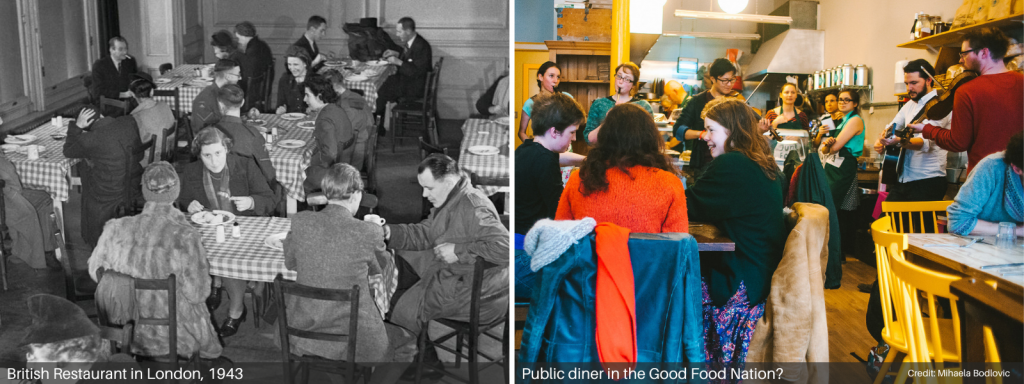It is a pub question waiting to happen: Which state sponsored a chain of 2,000+ restaurants serving a nutritionally balanced, price-capped menu to the general public? Russia? China? Venezuela? The correct answer is the UK under a Conservative Prime Minister.
British Restaurants operated across Britain during 1940’s and 50’s. They were state-subsidised, affordable public diners, serving healthy meals to communities across the country. What started as ‘communal feeding centres’ was quickly rebranded thanks to an intervention by Winston Churchill who wrote to the Minister of Food, Lord Woolton in 1941: I hope the term “Communal Feeding Centres” is not going to be adopted. It is an odious expression suggestive of Communism and the workhouse. I suggest you call them “British Restaurants”. Everybody associates the word restaurant with a good meal.
Churchill’s intervention set a standard and a level of ambition for these new public institutions. Far from being soup kitchens, they were described as ‘centres of civilisation’, their walls decorated with bespoke murals and at times art loaned from national collections. They operated with state-support and through a combination of volunteer and local authority effort. While they received a subsidy for start-up costs, they also had a strong economic model which used economies of scale: centralised kitchens produced some of the food off-site and many restaurants served 100+ meals a day. In 1943 there were 46 British Restaurants operating across West Scotland. There were 6 in Dundee alone.

How is this idea relevant now? The triple shocks of austerity, pandemic and the cost-of-living crisis exposed the fragility of our social infrastructure when it comes to food and nourishment. But that fragility goes beyond affordability. Our current diets are one of the key drivers of ill-health – yet making healthy choices is difficult in our ultra-processed, veg-poor, industrialised food environments. And with the rise of single-person households 1 in 3 of us regularly eat alone – yet we know that eating socially is good for our physical and mental wellbeing. The public diner is exactly the type of new social institution that could help us address these issues.
The British Restaurants might have started as an anti-poverty response, but the raising of ambition led to them gaining a broader appeal. It was an easy way to eat well at a time when women’s labour was suddenly concentrated outside the home. The public diners took care of meal planning, shopping, cooking and washing up – and even served up a decent pudding in a convivial atmosphere.
If the idea of state subsidised public dining sounds utopian, it’s worth considering the state’s support for other areas of our lives. When it comes to heath, we rely on an extensive network of GP surgeries, hospitals and clinics, supported by wider public health initiatives, telephone helplines, universal free prescriptions, even a network of sports centres and outdoor gyms for health promotion. Similarly, education is not reduced to mere schooling; here, the state supports adult learning initiatives, the Open University, public libraries, free access to museums and galleries, and the BBC. The state even supports the creation and upkeep of botanical gardens, public parks, theatres and dance troupes – all for our collective enjoyment.
The question isn’t really why we should have state-supported public diners. It is: why shouldn’t we?
We’re starting a bigger programme of work around public diners. Please get in touch with Miesbeth (miesbeth@nourishscotland.org.uk) if you’d like to join the mailing list for this project.